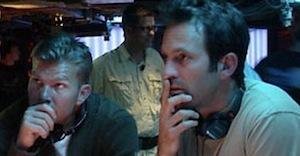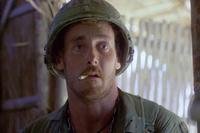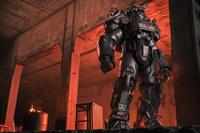
McCoy (center) and Waugh (right) on the set of Act of Valor.
Directors Mike "Mouse" McCoy and Scott Waugh aim to pull off an incredible balancing act with their new Navy SEALs movie Act of Valor. They attempt to deliver all the thrills of a high-end action picture while giving a true-to-life look at the issues face by the men and women who serve. AOV was made with the Navy's permission and support and how it fares once it hits theaters may have a big impact on military-themed movies in the future.
McCoy and Waugh sat down with Military.com for an interview about why they're not a part of the Hollywood system, how they got the movie made and how close they got with the SEAL community while making Act of Valor.
%embed1%
UTR: Let's talk about your backgrounds. Neither of you come from the traditional Hollywood movie system.
Mouse McCoy: Yeah, that’s for sure. I was a professional motorcycle racer for year, and a stuntman, and then turned into a producer/director from there. So it really basically raised my life from the film business and the action world, and the world of professional racing.
Scott Waugh: My father was the original Spiderman. I started out doing stunts when I was 12 and basically retired when I was 35 when I really got more heavily involved with producing and directing with Step Into Liquid and Dust to Glory. And then in my stunt career I spent four years as President of Stunts Unlimited, which is the top 50 stuntmen in the world. I don’t know if you know, but Mouse is definitely the iconic legend in motocross; he's being very humble right now. He won the Baja 500, and the Baja 1000, which are the most two prestigious off-road races in the world.
UTR: That’s really interesting because there's a real physical sense of how things are supposed to work in this movie that you don’t see in a lot of Hollywood action pictures, a sense that the people behind this movie understand the mechanics of how the machines work.
MM: Thanks. Well you know what started out is there was a real commonality of cultures overall. The team guys definitely liked the films we made previously, and ,when we were introduced and brought into the community, we all were sort of speaking the same language from the inception. We would never in a million years say we've been in a gunfight, but we've hung out pretty hard in our days, so there was a definite commonality there.
UTR: How did you connect with the Navy in the first place?
SW: Well they asked us into the community to take a look at what it would even look like to tell their story. And so we started to just explore that concept, and the community started to open up to us, and tell us some stories, and really unveil who they are, and what they're all about, and we really instantly connected with the sacrifice that’s been laid down in the last ten years. I mean, that was pretty mind-blowing to really connect with how hard that everyone in the military has sacrificed. And then you start to really get an understanding of how deep the brotherhood goes, and how that brotherhood has been forged in the history of the community.
And from that we started to really understand how really complex these guys were and how different they were from how Hollywood represented them.
UTR: Some of the editors here at Military.com have been involved in movie projects that would require DoD approvals and we're really surprised and impressed that you got the permissions you needed to make this movie.
MM: We really started to connect with the community and they saw they would have a hand in the film. So all the operational planning was done by the teams. On a day-to-day basis we would be writing dialogue together, and we really just set course in making it truly authentic and legit, and accurately represent the brotherhood.
UTR: A lot of the stories about Act of Valor make it sound like you started shooting a training film and then hired a screenwriter to develop a story that would tie the action sequences together. How accurate is that?
SW: We hadn’t shot any of the film before we hired the screenwriter. That’s just a myth going around town. We met with the community to try to extract the stories from within, and that’s where we discovered these five acts valor in particular that really resonated very strongly with Mouse and I. We didn’t believe some of it until they pointed to the guy next to them as the person who it happened to, and you just couldn’t believe it. And that is when we went back to Kurt Johnstad, our writer and said, "Okay, here are these five acts of valor that we love, we need to weave a fictitious story line through these five acts of valor." So that’s when we wrote the screenplay, Kurt wrote the screenplay, and then that's when we got the approval from CHINFO to move forward.
We kind of giggle when we hear things like that. Like they shot the whole movie and then somehow they hired a screenwriter to connect the dots. It really would never work that way.
MM: Mouse McCoy: And so it's important to know that everything that happens to a SEAL in this film has happened to somebody in the battlefield in the last ten years.
UTR: The other story we've read is that you were showing the film around LA for people in the movie business in February/March last year and then after the Bin Laden mission, you pulled it. What's the situation there?
SW: Yeah, well that’s not correct either. We did not show the movie at all. We had finished the movie in February and our strategy wasn’t to show the film to buyers until the middle of the summer. And when May 1st came around and Osama Bin Laden was taken down, a lot of people tried to grab the microphone and run with it, and Mouse and I said, "Absolutely not." They're like, "Because this would be a perfect time to sell your movie" and we said, "No." We pulled the movie down from everyone, said, "We will not show this movie this entire month because the limelight is deserved of the guys that it happened to, not a movie that’s not even about the Osama Bin Laden takedown."
MM: We went dark out of the respect of the community. We were not going to at all sort of capitalize on that moment; it just felt wrong to us.
SW: We all know Hollywood can be very narrow-minded, and they couldn’t understand the phrase that Mouse and I had always used for four years starting in 2008, which was, "You guys, we don’t have stars in our movie, we have heroes." And then of course after May 1st, Hollywood came up with this really great expression, "These guys don’t have stars in their movie, they have heroes." You're like, "Ah, I'm really glad you came up with that great idea."
UTR: How formal were the approvals for the guys who appeared in the movie?
MM: Well it's important to know is once we set course on using the real guys and doing everything in an authentic way, all the guys turned us down. They said, "We're not Hollywood, we're not trying to be actors. That's not what we do." And then as we kept moving forward and really earned their trust, and became friends, they really started to see that the operational planning was going to be done by them. On a day-to-day basis, they were going to have a hand in writing the dialogue as it would pertain the scene, and then the movie was about the brotherhood. And --
SW: Well, the sacrifice.
MM: And the sacrifice. And they felt it was going to pay respect to their community, and that’s when the guys came on board.
UTR: Was decision to credit them by first name only a security issue or is that just a personal decision from them?
SW: It’s a decision on them.
MM: Personal.
UTR: Are these guys thinking about the fame that might come their way once the movie comes out?
MM: All the guys are just back to work man. None of them were in it for that. You know a few guys are redeployed. It's important to note that during the making of this movie, almost everybody in the film went on a full time deployment.
UTR: How much did that delay the process of filming for you?
MM: The film took four years top to bottom from green light to distribution. And it took two-and-a-half years of principle photography.
SW: We were in-the-can done in February 2011.
UTR: So how long did you work on cutting it after you finished shooting it?
SW: Well we were -- I was cutting as we were going. So the editorial was a two-year process because I was cutting in the middle of filming.
MM: This is the first time live fire's been done in a movie in 100 years. And there's quite a bit of live fire in this movie.
SW: Yeah, we pride ourselves that we don’t use any CG in our movies. Everything's in camera, and I think the audiences are going to be refreshed to know that this is all based on physics, not an actor on green screen, which seems to be all the movies nowadays.
UTR: There's a real sense that you're very concerned with what it's like for these guys to live their lives while they're doing this job. That's something Hollywood's not ever been very good at.
MM: We realized that these guys are some of the most amazing family men we've ever met. They're great warriors, but they're just as dedicated fathers and husbands, and we really were influenced by the sacrifices the families and the wives have laid down. I mean the wives pay the tax in a lot of ways. And we really wanted to showcase what they go through; it was extremely important to us, and show that the guys are normal guys as well.
SW: Once we really got to be immersed in their culture, I realized that I don’t know what other people see. I don’t even understand how Hollywood comes up with these perverse viewpoints on our military. Because our military is so incredible. If you just objectively show what's really going on, it's pretty incredible.
UTR: Isn't that true for almost any non-Hollywood culture that Hollywood decides to make a movie about?
SW: Yeah, all of a sudden Hollywood always has to put their own little spin on it, and wreck it.
MM: You know it's important, we hope that this film is a paradigm shift, a cultural shift overall that finally puts the Vietnam hangover to rest. I think we've been in a 40-year hangover from Vietnam in the liberal arts. Hopefully, for us filmmakers, this movie sort of puts that to rest and opens a new light on what's actually going on.
SW: We did a screening for New York Fire Department, and New York Police Department a couple of weeks ago. We really wanted to let the guys that were hanging it out, the men and women in the homeland protecting us for no recognition see the movie first. And it was really wonderful to get their reaction. They thanked us for getting the story and that was very humbling.
UTR: Some of the most positive response we've heard is from guys who've served who were excited to see a movie where people cared about portraying what it's like to be a part of that community.
SW: Oh wonderful. It's really rewarding to know. You got to remember the harshest critics are definitely going to be the 2,200 SEALS that are active duty right now.
MM: And we're really happy to say the community has embraced it, and thanks us for making it. And we really look to them for the guide track of this film; it was a real partnership. I mean, so much of this film just came out of their voice.
UTR: There's some other news reports out there that you're about to start filming a movie called Black Sands that stars Arnold Schwarzenegger.
SW: Well we haven't really focused a lot on that at all right now. Mouse and I are just still on Act of Valor. So it's just one of the projects we're developing right now, and there's no green light commitment to us doing that in the next few months. We have to get off this first.
MM: Yeah. We're still really loving being a part of this movie; it's been the best experience of our lives. So we're still trying to sort of hang in the moment.




